Manningtree circular
6 June 2020. I had intended to lead a ramble from Gomshall to Shere, a walk that Rosemarie was happy to hand over to me, but as I had no chance to recce it I decided to take you instead on one of my favourite walks through Constable country, a circular from Manningtree, Essex.
From the station, out of the car park we pick up a narrow path leading up to St. Mary’s Church, Lawford, an English Heritage Grade I listed building. It is an Anglican Parish church in the deanery of Harwich, the archdeaconry of Colchester, and the diocese of Chelmsford.
From the Church we join the Essex Way which takes us across a large field, then weaving around the side of an old barn and a house with a beautiful garden. Soon we cross over the railway – two high stiles either side with the signs STOP, LOOK, LISTEN, telling us to be extra careful. From there slightly uphill across a meadow we join a fenced off path through paddocks. “Hello you two beauties”.
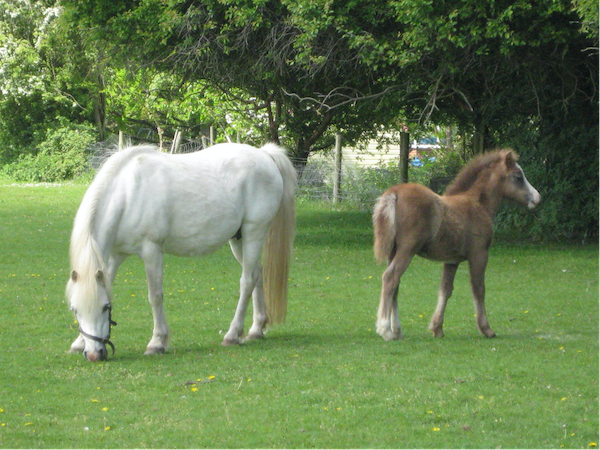
After crossing a road and over a stile we walk diagonally through a small buttercup carpeted meadow – then along a lane, from where a gate leads us to the ridge of fields on a slightly higher plane. To our right, looking down through the lush foliage of Dedham Vale, we can just about make out the top of the tower of Dedham church. At the end of the fields an enclosed path takes us out on to a road, we pass a few lovely cottages, through someone’s private garden (a public footpath) leading us to a paddock and some more fields. Eventually this takes us on to a playing field adjoining the church yard of St. Mary the Virgin Church. The present church dates from 1492 and it is worth to look inside.
Dedham is a very attractive country town to explore and worth a longer visit as an hour’s lunch just doesn’t do it justice. A quote from Pevsner says “There is nothing to hurt the eye in Dedham” and I couldn’t agree more. It is also worth a mention that John Constable went to school here. We can choose to lunch at ‘The Marlborough Head Inn’, ‘The Sun Inn’ or ‘The Essex Rose’ café, just to mention a few.
After lunch we make our way past Dedham Hall to reach the river Stour – lovely to see a couple of rowing boats gliding along, cows grazing by the edges of the river bank – the trees and broad sky scape with a few puffy white clouds makes it impossible not to envisage at least one of Constable’s rural paintings. We veer to the left to reach a small wooden footbridge to cross the river, then on to a long path with trees either side holding hands above us, the sun throwing dappled light spots through the trees on to the path. After a gradual uphill we reach a road with the sign ‘Welcome to Suffolk’. We have arrived in East Bergholt, the birthplace of John Constable.
Right at the corner of the junction is their Parish Church of St. Mary the Virgin. It does not have a bell tower but instead it has a very impressive bell cage with five bells which are, (quote) ‘rung by pure force of hand applied directly to the bell and not by rope and wheel’. I remember when I led this walk a few years ago there was a wedding taking place. The bell ringers were waiting for the couple to come out of the church. After some pleading by the group ‘please can we stay to hear the bells?’, I gave in and we waited for a considerable time before we could see first-hand how it was done and also to enjoy the magnificent sound. http://www.constablecountrychurches.co.uk/.
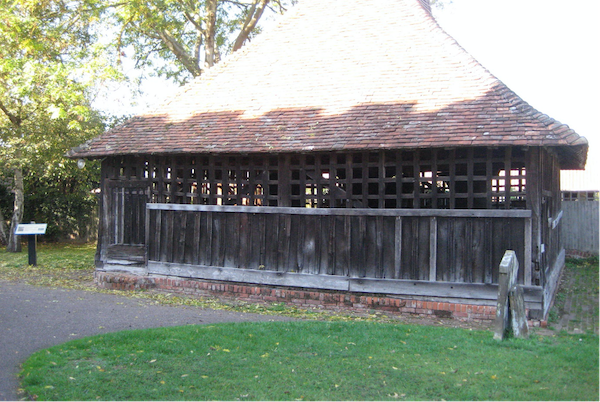
East Bergholt was famous for its cloth trade, and (quote) ‘by the 15th Century rose to be the most important clothing town in the Samford Hundred, but with the decline of the cloth trade in the late 16th century it reverted to a village primarily concerned with farming’.
Also worth exploring in more detail as there are still some of the original old houses linked to the cloth trade. The layout of the town is roughly in the shape of a horse shoe, built around the common protected by law for grazing cattle. (I imagine that nowadays it’s more used for dog walking). Alas, Constable’s birth house, located near the church, is no longer there but commemorated by a plaque on the garden wall.
However, I am not taking us around the horseshoe shaped part of the town as, from previous experience, the pavements are extremely narrow and often non-existent – not good for a group of walkers. We’ll take the straight route from the church along lovely cottages to our left and a farmstead to our right (might even spot a turkey roaming about) until we come to a junction where we turn right, with a road sign pointing towards Flatford Mill. We divert a little to access a narrow path behind open fields – rather overgrown right now, so please mind the brambles and nettles. Eventually, we arrive at Willi Lott’s cottage by the pond.
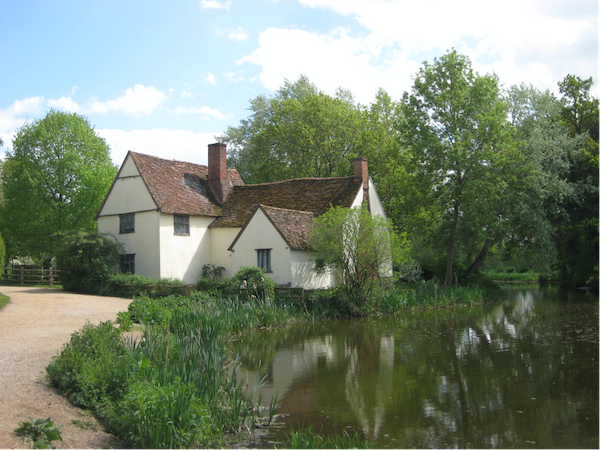
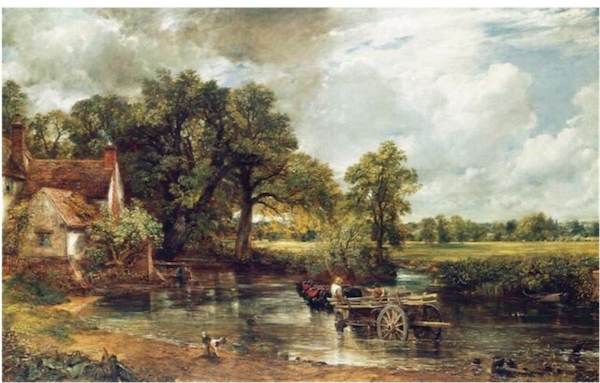
Constable’s famous painting ‘The Hay-Wain’ shows a cart being drawn across that very pond by two horses and with Willi Lott’s cottage partially visible on the edge of the pond.
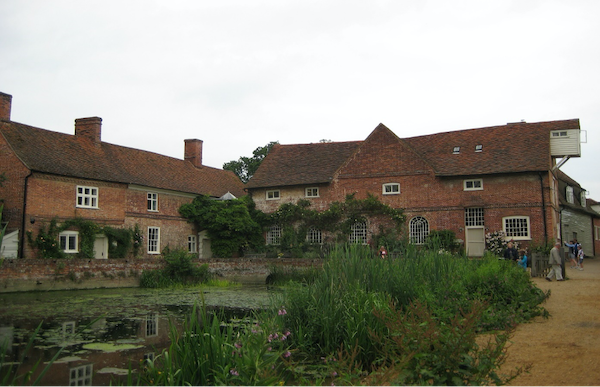
Flatford Mill was owned by John Constable’s father and he very much wanted his son to take over the business to continue with the wool & cloth trade, but John was not interested – he wanted to be an artist. Willi Lott, who was a local farmer and foreman at the Mill was a great friend of John and he continued running the Mill for many more years after the death of John’s father.
Flatford Mill is now owned by the National Trust and is used as a Field Study Centre – https://www.nationaltrust.org.uk/flatford.
Now, let’s walk up the lane to the Café where scrumptious cakes, ice cream and liquid refreshments are on offer – looking out over the river Stour – quintessentially English (in my humble opinion).
After refreshments, a little rest and maybe a brief visit to the small NT information centre and a nose around the shop, we cross the bridge to the other side of the Mill and turn left along the river up to a T-junction. Turning left we walk on a high path along the banks of the river to our left. Here it is very overgrown with high reeds so that we’ll have a job spotting the water. Eventually we’ll have to turn off from the river bank, with a half-hour’s walk back to Manningtree station. Oh dear! – just missed the train back to London. No worries – we can drop into the ‘Station Buffet’ at the end of the platform for more refreshments (and not just soft drinks!) – what’s not to like?
An additional note: Not far from Dedham, approx. 20 minutes’ walk, you’ll find the ‘Munnings Art Museum’ at Castle House. It was the home of the artist Sir Alfred Munnings and his studio, in a separate barn is also open to visitors. Besides there’s a lovely tea room in the gardens. All worth a visit when you are next in Dedham Vale maybe for a bit longer than just on a day’s outing – munningsmuseum (watch out, strange opening times).
I hope you enjoyed the walk – I did.
Till soon, hopefully, Sigrid


